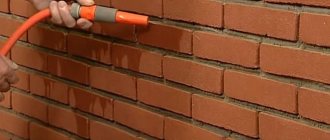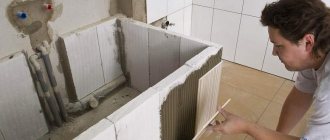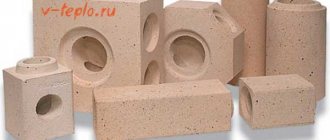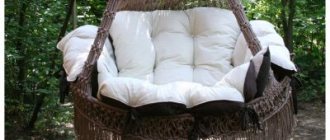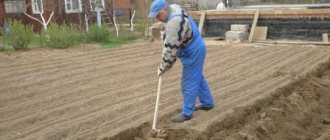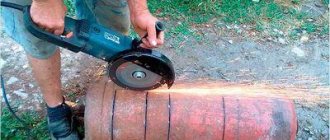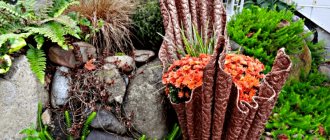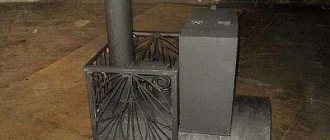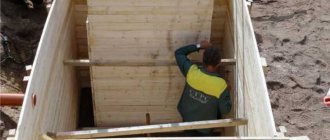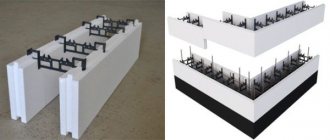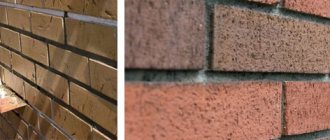High-quality laying of decorative bricks in rooms and non-residential premises of an apartment or private house can complement any design style. Owners can choose for use both materials used for facade cladding and inexpensive wall panels and tiles. First of all, owners are advised to determine how much each type of product costs. After selecting suitable materials, you need to calculate the number of products required for cladding. Owners will also have to buy auxiliary tools and consumables. It is not difficult to carry out cladding in a new building or renovate an old home yourself, following the recommendations of specialists. Careful preparation and compliance with basic requirements will help you easily carry out the renovation without the involvement of craftsmen and get an original design for all rooms of your home.
Ready-made gypsum tiles
This is one of the simplest and most successful ways to decorate a wall: the tiles are sold in boxes, their quantity is easy to calculate.
It weighs little and requires minimal effort when facing. It comes in a variety of colors and can imitate aged masonry. Gypsum “bricks” are attached with special glue. Carry out the cladding as carefully as possible so that the adhesive is not visible in the seams. The finished wall can be painted to even out the color, or varnished.
Another advantage of facing tiles is its environmental friendliness, since gypsum is a natural material. The wall will last for several years and will provide additional sound insulation.
Bricklaying methods
Choosing their optimal location will help you correctly lay finishing bricks in a building. The following types of masonry exist:
- spoon This is done by shifting all the elements of the new row by 1/2 or 1/4.
- tychkovaya. The elements are laid out with the short side. Each row is shifted by 1/2 element.
- Dutch. One row - laying out the elements with the short side. The next row is alternating the standard layout and the short side layout.
- Gothic The first row is alternating the long and short sides of the elements. Subsequent rows - shift the short side by 1/2 relative to the previous row and a corresponding shift of the long side by 1/3.
- Flemish Alternating long and short sides of materials. Each subsequent row is laid out with such an offset that the short sides of the elements of the previous row are located under the elements laid with the long side.
Wallpaper
The method is suitable for those who want to imitate a brick wall quickly, but do not pay attention to the volume of the texture. To achieve maximum realism, choose vinyl or non-woven fabrics: all the cracks and folds are visible on them, and the “brick” itself is slightly convex. Paper wallpaper has a less clear pattern and does not last as long, but is cheaper.
Another option is high-quality photo wallpaper, but their price is equal to the cost of gypsum tiles.
Final view of the house
Yellow brick will help to enhance the surface if you use it for cladding. For the roof, metal tiles are considered a good option. The material is affordable, looks beautiful, is durable and durable. It is possible to use an option with a dark red roof, but this combination will be too bright and catchy. An alternative is a house with a brown roof made of tiles or copper sheets. In order to better play with color and place the right accents, brown windows are used.
PVC panels
Designed for decorative finishing of hallways, kitchens, bathrooms or balconies. The polyvinyl chloride from which the panels are made is not afraid of water, and the minimum thickness of the product gives it elasticity. Some will consider this a disadvantage, while others will turn it into an advantage by creating semicircular or uneven surfaces and easily cutting the required amount of material with scissors.
For installation, glue or liquid nails are used. Some products already contain an adhesive layer. The main disadvantages of the panels are the repeatability of the pattern, as well as seams and artificiality of the material, visible to the eye.
What difficulties may arise?
Attention
The most important task during finishing is leveling the surface of decorative stone tiles at the corners. In this case, the solution must be of the required consistency, since too thick will not allow the elements to be aligned freely, and too liquid will absorb the tiles and “float”.
To ensure easier and more reliable installation of corner elements, it is necessary to extend the finishing coating in this area. If the linings are heavy or made of natural stone, then you need to use special adhesives and prepare the surface more responsibly.
Finishing corners with decorative stone is the most difficult part in installing decorative stone. If natural materials are used, then specially made corner elements are not always used. This makes installation slightly more difficult, since it requires an electric tile cutter and the ability to operate it. If all the requirements for finishing with decorative stone are met, you can install such cladding on the corners yourself.
MDF panels
This material is more environmentally friendly and durable. It is a semi-solid sheet measuring about 2.5 x 1.20 m. The embossing is shallow, but, unlike plastic, it looks more convincing. The panel is attached to liquid nails and joined to the next one, forming a continuous masonry.
The design, made with high-quality digital printing, withstands cleaning well. Not suitable for imperfectly aligned walls, but successfully hides minor defects.
Drywall
A method for lovers of smooth brickwork and handicrafts. In addition to gypsum board, you will need a stationery knife and a ruler, and putty to give the material texture.
First, a sheet of plasterboard is cut into even strips 65 mm wide, then cut on both sides and broken. Bricks are formed from the resulting strips.
If the cladding area is large, the process takes a long time. The finished elements are fixed with ordinary tile adhesive.
The surface can be left smooth or, by removing the top layer of cardboard, you can make notches and irregularities on it. You can imitate the texture and seams between tiles using putty or glue, and transfer the color with acrylic or water-dispersion paint.
A more detailed master class can be found in this video:
Brick wall in the office - the luxury of simple solutions
It is quite easy to decorate your office and create a special atmosphere in it using stylized cladding. Plain materials in white, yellowish or light brown colors can be placed directly in front of the desktop. Dark and red-brown materials are ideal for full cabinet cladding. Such a range, maintained in decoration and furniture, will promote measured reflection.
To complement the chosen style, you can install a rack for documents, books and modest souvenirs against the background of one of the walls. But the design solution with the creation of columns and niches, complemented by unusual cladding, is also attractive. Between the columns or in niches you can place shelves for work materials and personal items. Wooden furniture in brown or coffee color will harmoniously combine with the created design.
Expanded polystyrene
To create such bricks, ordinary foam is used. Some are content with the remains of ceiling tiles (but the elements from them turn out to be too thin), while others purchase sandwich panels and cut them into tiles about 1 cm thick. Polystyrene foam can be easily processed with an ordinary construction knife: with its help you can create the desired texture, and add fine relief with a wire brush.
This lightweight material easily sticks to walls, but does not have high strength, so it is not recommended for rooms with high operating loads. You should also take into account the painstaking nature of the work - preparing the elements requires time and patience.
Selection of material
Recently, stone finishing has become even more popular. Therefore, the question of choice is becoming increasingly acute for consumers. Among the many types and types of finishing in this class, it is necessary not to make a mistake with the texture, origin, size, and other qualities of decorative stone cladding.
Popular materials: stone slabs and artificially made blocks.
- The first category includes granite, marble, dolomite, sandstone, dense-textured limestone, quartzite and others.
- In the second - flexible, gypsum, cement and other materials.
Advice
Materials of artificial origin are better suited for interior decoration. They are easier to wash and keep clean, and are significantly lighter than their natural counterparts.
When choosing, you must adhere to the following rules:
- Compliance with the chosen interior style and color scheme.
- Reliable protection against mechanical influences.
- Moderation, since the abundance of stone on the walls makes the room heavier, making it more like a crypt or utility room.
Natural
Various natural materials can be used to decorate these areas of the wall surface.
It is necessary to note the high price of the elements that create a continuous corner, which are carved from a larger workpiece. Therefore, when facing, they often use ordinary straight slabs, but with trimming the contacting elements at 45°. When two adjacent slabs are connected to each other at the cutting points, their outer layer creates the impression of a monolithic stone surface.
Such work is a highly complex installation and requires the use of an electric tile cutter . But it is still cheaper than purchasing special corner monolithic elements made from natural material.
Artificial
Cladding with artificial decorative stones is significantly cheaper than with natural analogues. First of all, this is due to the lower price of raw materials, since even special corner elements are cheaper than direct analogues of natural origin. But attaching them to walls is a little more difficult. It is necessary to correctly and evenly apply the mortar to the surface of the tile or wall so that a minimum of voids is formed.
More convenient options for artificial stones are available as flexible ones. They can be used to cover even sharp corners, without damaging the decorative layer as a result of bending the fabric base. The strength of the elastic coating is not much lower than its harder counterpart, since the outer layer contains up to 90% marble, granite chips or other mineral particles.
Attention
The most popular artificial decorative stones for finishing are concrete and gypsum tiles or bricks (the use of decorative stone for brick is described here). They differ in strength and other characteristics, weight. Gypsum fragments are less durable, lighter and non-waterproof, and require additional paint and varnish coating.
Read about how to paint decorative stone here.
Flexible tiles
This material consists of 90% marble or quartz fraction and acrylic binders. The flexible base allows you to cover corners, and due to its moisture resistance, the “brick” can be used in rooms with high humidity – bathrooms and swimming pools. Also suitable for decorating facades. Available both as individual elements and in rolls. Installation requires an acrylic primer and adhesive specifically for flexible stone.
The advantage of the material is durability (25 years of service), the disadvantage is high price.
Brick-like porcelain tiles
Another reliable material for wall cladding in a bathroom, hallway or loggia. Porcelain tile is environmentally friendly, can withstand high loads, looks noble, and its matte rough surface successfully imitates real brick.
It is considered an expensive type of finishing because it includes the costs of material, careful preparation of the surface and laying of tiles by professionals.
Brick finishing in the bedroom
The use of original artificial materials makes it easy to transform the interior of a bedroom for adults or teenagers. To stylishly decorate a boy’s room, it is recommended to give preference to products in gray-brown or similar colors. They will help create a “rebellious” style. Materials in purple, light gray, and white colors are perfect for a girl’s bedroom. In the parents' bedroom it is recommended to glue yellow and reddish-brown elements. They will emphasize the special comfort of the room. Using such materials you can style the wall behind the bed (located behind the headboard).
It is not necessary to use the selected materials to cover the entire wall. They can be laid out only in the lower or upper part, representing a vertical canvas, framed on the sides with regular painting. Such cladding around bedroom windows would look appropriate. An interesting solution is the use of stylized materials to decorate wall niches in the room.
Plaster, masking tape or stencil
This method allows you to make an imitation of brick for little money. You will need:
- primer;
- plaster;
- thin masking tape;
- level;
- paint and brushes.
Step-by-step instruction:
- We prime the wall, mark it with a pencil and stick it with tape, leaving “tails”.
- We apply the plaster and, without waiting for it to dry completely, remove the tape.
- We smooth the edges with a moistened sponge or, conversely, give the bricks a relief. The dried wall turns out durable, similar to real brick.
- We paint it in any suitable color.
When creating brickwork in this way, prepare for a lot of dirt and dust. Instead of tape, you can use a ready-made or homemade stencil.
Features of the work
Before starting facing work, the total coverage area is calculated. For these purposes, use the formula:
- S = dxh, where S is the area of the walls, d is the length, h is the height.
From the finished result, the sum of the areas not subject to cladding is subtracted - window and door openings. To find out the required number of corner elements, first measure the height of the external or internal corners required for finishing. Afterwards, the areas that will be covered with corner materials are subtracted from the main coverage area. When purchasing artificial bricks, it is recommended to take a small reserve - on average about 5%, in case of unexpected damage, selection, trimming.
Tile adhesive, level or roller
Instead of plaster, you can use tile adhesive - it is more resistant to moisture, but is also considered a budget option. To create an imitation of brickwork with your own hands, apply glue to the primed wall and unstitch the seams using a level and any suitable tool - all that remains is to remove the excess glue.
To imitate uneven aged brick, you can purchase a special roller: this way you will save time, but not money.
Most of the examples given do not require significant costs, and the effectiveness and persuasiveness of brickwork depends on the accuracy and artistic taste of the master.
Brickwork in the kitchen interior
Using stylized tile materials in the kitchen is a practical solution. They will ensure ease of cleaning. Additionally, they will help emphasize the sophistication of the design. Perfect for modern, modern and loft style. It is recommended to use such materials for all walls or to decorate the work area: an apron and walls near the sink, stove, refrigerator, and cooking countertops.
Preference should be given to products with glossy surfaces. It is easy to clean from any dirt. You should not buy matte relief materials. Such lining will be very difficult to clean. The color scheme of materials can be any, suitable for the chosen style. But you need to remember that white and cream tiles on the backsplash or behind the stove will require frequent cleaning. In these parts it is better to use orange, red-brown or dark gray tiles.
